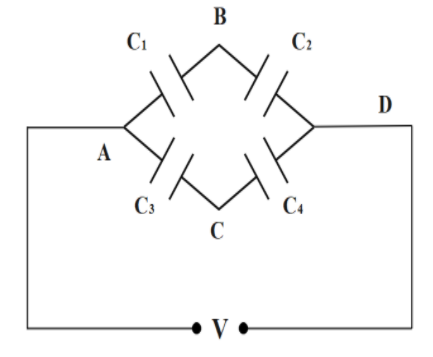Answer
405.3k+ views
Hint: A capacitor is a two terminal component which stores electrical energy in the form of potential energy later discharges them. This property of capacitors is called the capacitance of the capacitor. Also, capacitors can be connected in series or in parallel circuits with respect to each other.
Formula: $\dfrac{1}{C_{s}}=\dfrac{1}{C_{1}}+\dfrac{1}{C_{2}}$ and $Q=CV$
Complete answer:
A capacitor is an electrical device which can store electrical energy, and behaves as a temporary battery. These are used to maintain the power supply. It is one of the main components used in full wave and half wave rectifiers. (symbol: F), named after the English physicist Michael Faraday. Also, 1 farad capacitor, when charged with 1 coulomb of electrical charge, has a potential difference of1 volt between its plates.
We know that the charge $Q$ produced due to capacitance $C$ and potential difference $V$ is given as $Q=CV$. Also, the energy of the capacitor is $E=\dfrac{1}{2}CV^{2}$.
Clearly, from the given circuit, we can say that the capacitance $C_{1}$, $C_{2}$ are in series connection, similarly, the capacitance $C_{3}$, $C_{4}$ are in series. The resultant of the two are in parallel capacitance.
Then we can say that $C_{a}=\dfrac{C_{1}C_{2}}{C_{1}+C_{2}}$ and similarly, $C_{b}=\dfrac{C_{3}C_{4}}{C_{3}+C_{4}}$.
Then the charge $Q_{a}$ and the potential $V$ due to $C_{a}$ will be given as $Q_{a}=C_{a}V$
$\implies Q_{a}=\dfrac{C_{1}C_{2}V}{C_{1}+C_{2}}$ .
Also, $V_{2}=\dfrac{Q}{C_{2}}=\dfrac{\dfrac{C_{1}C_{2}V}{C_{1}+C_{2}}}{C_{2}}$
$\implies V_{2}=\dfrac{Q}{C_{2}}=\dfrac{C_{1}V}{C_{1}+C_{2}}$
Similarly, the charge $Q_{b}$ and the potential $V$ due to $C_{b}$ will be given as $Q_{b}=C_{b}V$
$\implies Q_{b}=\dfrac{C_{3}C_{4}V}{C_{2}+C_{4}}$ .
Also, $V_{4}=\dfrac{Q}{C_{4}}=\dfrac{\dfrac{C_{3}C_{4}V}{C_{3}+C_{4}}}{C_{4}}$
$\implies V_{4}=\dfrac{Q}{C_{4}}=\dfrac{C_{3}V}{C_{3}+C_{4}}$
Then the potential difference between the points BC id given as
$V_{BC}=V_{2}-V_{4}$
$\implies V_{BC}=\dfrac{C_{1}V}{C_{1}+C_{2}}-\dfrac{C_{3}V}{C_{3}+C_{4}}$
$\implies V_{BC}=\dfrac{C_{1}V(C_{3}+C_{4})-C_{3}V(C_{1}+C_{2})}{(C_{3}+C_{4})(C_{1}+C_{2})}$
$\therefore V_{BC}=\dfrac{V(C_{1}C_{4}-C_{3}+C_{2})}{(C_{3}+C_{4})(C_{1}+C_{2})}$
Hence the required answer is option \[D.\dfrac{{{C}_{1}}{{C}_{4}}-{{C}_{2}}{{C}_{3}}}{({{C}_{1}}+{{C}_{2}})\times ({{C}_{3}}+{{C}_{4}})}V\]
Note:
The series of capacitors is the sum of reciprocal of its individual capacitors, whereas in resistance the parallel is the sum of reciprocal of its individual resistors. Also remember that capacitors can charge and discharge.
Formula: $\dfrac{1}{C_{s}}=\dfrac{1}{C_{1}}+\dfrac{1}{C_{2}}$ and $Q=CV$
Complete answer:
A capacitor is an electrical device which can store electrical energy, and behaves as a temporary battery. These are used to maintain the power supply. It is one of the main components used in full wave and half wave rectifiers. (symbol: F), named after the English physicist Michael Faraday. Also, 1 farad capacitor, when charged with 1 coulomb of electrical charge, has a potential difference of1 volt between its plates.
We know that the charge $Q$ produced due to capacitance $C$ and potential difference $V$ is given as $Q=CV$. Also, the energy of the capacitor is $E=\dfrac{1}{2}CV^{2}$.
Clearly, from the given circuit, we can say that the capacitance $C_{1}$, $C_{2}$ are in series connection, similarly, the capacitance $C_{3}$, $C_{4}$ are in series. The resultant of the two are in parallel capacitance.
Then we can say that $C_{a}=\dfrac{C_{1}C_{2}}{C_{1}+C_{2}}$ and similarly, $C_{b}=\dfrac{C_{3}C_{4}}{C_{3}+C_{4}}$.
Then the charge $Q_{a}$ and the potential $V$ due to $C_{a}$ will be given as $Q_{a}=C_{a}V$
$\implies Q_{a}=\dfrac{C_{1}C_{2}V}{C_{1}+C_{2}}$ .
Also, $V_{2}=\dfrac{Q}{C_{2}}=\dfrac{\dfrac{C_{1}C_{2}V}{C_{1}+C_{2}}}{C_{2}}$
$\implies V_{2}=\dfrac{Q}{C_{2}}=\dfrac{C_{1}V}{C_{1}+C_{2}}$
Similarly, the charge $Q_{b}$ and the potential $V$ due to $C_{b}$ will be given as $Q_{b}=C_{b}V$
$\implies Q_{b}=\dfrac{C_{3}C_{4}V}{C_{2}+C_{4}}$ .
Also, $V_{4}=\dfrac{Q}{C_{4}}=\dfrac{\dfrac{C_{3}C_{4}V}{C_{3}+C_{4}}}{C_{4}}$
$\implies V_{4}=\dfrac{Q}{C_{4}}=\dfrac{C_{3}V}{C_{3}+C_{4}}$
Then the potential difference between the points BC id given as
$V_{BC}=V_{2}-V_{4}$
$\implies V_{BC}=\dfrac{C_{1}V}{C_{1}+C_{2}}-\dfrac{C_{3}V}{C_{3}+C_{4}}$
$\implies V_{BC}=\dfrac{C_{1}V(C_{3}+C_{4})-C_{3}V(C_{1}+C_{2})}{(C_{3}+C_{4})(C_{1}+C_{2})}$
$\therefore V_{BC}=\dfrac{V(C_{1}C_{4}-C_{3}+C_{2})}{(C_{3}+C_{4})(C_{1}+C_{2})}$
Hence the required answer is option \[D.\dfrac{{{C}_{1}}{{C}_{4}}-{{C}_{2}}{{C}_{3}}}{({{C}_{1}}+{{C}_{2}})\times ({{C}_{3}}+{{C}_{4}})}V\]
Note:
The series of capacitors is the sum of reciprocal of its individual capacitors, whereas in resistance the parallel is the sum of reciprocal of its individual resistors. Also remember that capacitors can charge and discharge.
Recently Updated Pages
How many sigma and pi bonds are present in HCequiv class 11 chemistry CBSE

Why Are Noble Gases NonReactive class 11 chemistry CBSE

Let X and Y be the sets of all positive divisors of class 11 maths CBSE

Let x and y be 2 real numbers which satisfy the equations class 11 maths CBSE

Let x 4log 2sqrt 9k 1 + 7 and y dfrac132log 2sqrt5 class 11 maths CBSE

Let x22ax+b20 and x22bx+a20 be two equations Then the class 11 maths CBSE

Trending doubts
Fill the blanks with the suitable prepositions 1 The class 9 english CBSE

At which age domestication of animals started A Neolithic class 11 social science CBSE

Which are the Top 10 Largest Countries of the World?

Give 10 examples for herbs , shrubs , climbers , creepers

Difference between Prokaryotic cell and Eukaryotic class 11 biology CBSE

Difference Between Plant Cell and Animal Cell

Write a letter to the principal requesting him to grant class 10 english CBSE

Change the following sentences into negative and interrogative class 10 english CBSE

Fill in the blanks A 1 lakh ten thousand B 1 million class 9 maths CBSE




